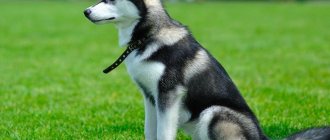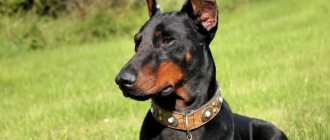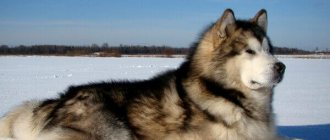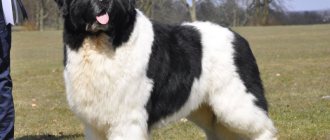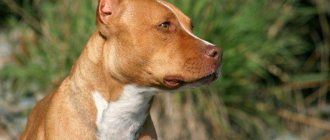The Hungarian Vizsla is a stately, graceful, elegant hunting dog with a lot of energy and one hundred percent people orientation. The Hungarian Pointer, as the breed is also called, differs from its gun-breeding relatives in its rich copper coat color and incredibly expressive eyes. The Vizsla is an excellent hunter, but it can also become a loyal friend and companion, which is why this breed is increasingly being kept as pets.
What do you need to know about keeping and training this breed of hunting dog? Why can't this breed live in an enclosure? What nutrition is needed to keep a cop in good shape? How is the Hungarian Vizsla dog different from other cops? Carefully study our article to find answers to all questions that may interest you.
Who is the breed suitable for?
- Hunters . This point is all clear. Hunting dogs must hunt, and the ideal owner for a Vizsla is a hunter. In any weather and in any conditions, pets are ready to be close to their hunter owner.
- Active people . If you are not a hunter, but like to spend your free time actively, play sports, are passionate about hiking, or just run every day in the morning, take a Vizsla as your companion. Dogs of this breed do not like to sit idle. They prefer an active walk to sleeping on the couch.
- Families with children of middle and high school age. The Hungarian Vizsla can become a friend and active companion for your children when they grow up. We wrote about the dangers of bringing children into families with small children a little higher. Teenagers and high school students will be able to control the dog, and it will respond to them with its affection and devotion.
Advantages
Owners of Hungarian Coppers dote on their pets. How can you not love such loyal and intelligent animals? Breeders boldly declare the main advantages of the breed:
- Sociability, lack of aggression, friendliness to people and animals;
- Love for children;
- Mobility, energy;
- Balance, calmness;
- Sensitivity (the dog senses emotional fluctuations, knows when to approach the owner and when not to);
- Unobtrusiveness;
- Loving nature;
- Developed intelligence and quick learner.
Who is the breed not suitable for?
- Sedentary people . Hungarian Vizsla and couch time are two mutually exclusive concepts. If you adopt this breed, forget about the sofa and TV. You need to run, jump, swim, do training and dog sports, throw a stick and Frisbee, and walk a lot with her. Don’t just take him out on a leash to relieve himself, but let him frolic in the forest, in a park, near a pond. It is advisable to play with her - and all her games are active. If you want a companion for watching TV series, take a closer look at pugs and French bulldogs.
- For aggressive owners . Vizslas do not tolerate violent behavior. Even during training, praise and encouragement work best. The breed is very sensitive, therefore touchy and vindictive. An offended dog can bite a person.
- People who spend most of their time at work . Dogs need human company at all times. They cannot stand loneliness. If you leave a Vizsla alone all day, don't scold him later for chewing up the sofa, ruining your shoes, or knocking over flower pots. Get yourself a better dachshund or sharpei.
History of the origin of the breed
Not as much is known about the history of the origin of this breed as we would like. It is believed that the first bright red Hungarian cops appeared on the territory of modern Hungary back in the 10th century. They accompanied the nomadic tribes of the Magyar conquerors. Gradually, the nomads’ favorites gained popularity among the Hungarian nobility, and the dogs began to be used in falconry. Confirmation of this fact can be found in the paintings of artists of the 14th century.
During the First World War, dogs of this breed were used as messengers. At the same time, the breed was on the verge of complete extinction. Active work to restore the number of Hungarian Vizsla dogs was carried out by enthusiasts in the post-war years. As a result of this activity, in 1936 the breed was recognized by the European club FCI. In 1960, the restored breed was recognized by the American Kennel Club.
Weimaraner (Weimar Pointer)
- Height: from 59 to 67 cm
- Weight: from 25 to 40 kg
- Life expectancy: 11-14 years
- Personality: strong, calm, intelligent, stubborn, aloof, energetic, vigilant, playful
The Weimar Pointer moves with great speed, has high endurance and combines grace, stamina and alertness. These are the aristocrats of the dog world with a kind expression on their faces. Their gait is smooth and relaxed. The short, smooth coat of Weimar Pointers has a unique gray color.
German dog breeds have earned a reputation for being some of the best breeds in the world. The Weimaraner originated in the nineteenth century in an attempt to create the perfect all-around dog that could hunt game of any size, including deer and bear. This work was sponsored by the Weimer Court.
Did you know that the breed was originally known as the Weimar Pointer . Bloodhounds, German hounds and early pointing breeds were taken as the basis of the breed.
The origin of the Weimar Pointers' characteristic gray coloring is unknown, but it was an early feature of the breed. This breed was strictly controlled by the German Weimaraner Club. Dogs could not be purchased by non-members, and membership was difficult to obtain.
Today, the beauty of the breed and the ability to be an excellent companion have earned the Weimar pointer regular fans. This is a brave and exuberant pet , sometimes too lively for small children. Weimaraners love to run and hike and can become destructive if not provided with enough exercise.
IMPORTANT! The Weimar Pointer may not get along well with small pets if they are not properly socialized. They can be stubborn or headstrong, but are often easy to train. They are best suited for an active family who loves sports and having fun. Some describe Weimaraners as pets that require a lot of attention.
The Weimaraner simply needs daily exercise. They are not suitable for city life unless their owner runs daily. Even then, they need to stretch their legs, run around, and explore a large, safe area. Fur care is minimal: from time to time you need to comb the fur with a special brush.
Description of the Hungarian Vizsla breed
The Hungarian Vizsla is a robust, multifunctional hunting dog that specializes in working under the gun. When hunting, he works confidently in any conditions and is not afraid of bad weather or fatigue. Not afraid of a shot or water. It takes pleasure in taking game out of the water without losing the ability to monitor its surroundings. He has a calm, friendly character and a noticeable noble exterior. Outside of work, he makes an excellent companion dog.
Application
The use of Hungarian Vizslas has not changed over the years - they are still actively used for gun hunting. The working characteristics of the breed are predetermined by a keen sense of smell, quick reaction and innate instincts. The pointer always monitors the actions of the owner and performs best on long hunts at a calm pace.
Hungarian cops do not get angry and remain calm when tracking down prey. The nature of hunting with a Vizsla is always distinguished by thoroughness and scrupulousness. A shot bird will never be lost, and a hare will never hide from a dog in a hole. The pointer will no doubt make its way through dense thickets, and its smooth coat allows it to swim well. The dog will not be frightened by cold water, but it is better not to subject it to such tests, because they have almost no undercoat.
Vizslas do not exhibit guarding or guarding qualities, and are also absolutely useless as herding dogs.
A sharp mind and quick wit help representatives of the breed to show excellent results in sports competitions. They can also be trained as guide dogs, and a good sense of smell gives them a chance to become good search engines.
Breed standard
Exterior features according to the European breed standard FCI
- Body type . Harmonious, elegant, dry.
- Back . Straight, muscular, strong.
- Lower back . Straight, slightly convex, muscular. Should be wide and short.
- Limbs . Straight and parallel. With well-developed bones and muscles.
- Paws . Slightly oval. The pads are painted grey. Claws are brown. Fingers are strong and arched.
- Gait . A beautiful trot with an elegant long stride.
- Croup _ Wide.
- Breast . Deep, muscular, well developed.
- Neck . Dry, moderate length. With a scruff, but without dewlap.
- Head . Proportional to the body. Dry. It looks noble.
- Scull . Slightly convex. Not very wide. A characteristic groove runs from the stop to the occipital protuberance.
- Muzzle . Blunt without sharpening. Muscular.
- Nose . With a straight back. The lobe is wide and developed. The nostrils are wide. Dyed to match the color of wool, but several shades darker.
- Jaws . Strong. Powerful. The teeth are vertically positioned. The bite is scissor-shaped.
- Ears . Soft. The tips are "V" shaped. Length 3/4 of the length of the head, adjacent to the cheekbones.
- Eyes . Oval, brown, with tight-fitting eyelids. The expression is smart and lively.
- Tail . Very low set. Thick at the very base, tapering towards the end. In some countries it is stopped by 1/4.
- Leather _ With strong pigmentation, it fits tightly to the body without wrinkling.
- Coat . Short and dense throughout the body. No undercoat. Tough. Thinner and softer on the head and ears.
- Color . Homogeneous. From wheat shades to reddish-golden.
- Weight . There is no breed standard. On average - from 18 to 27 kg. Males can reach 30 kg.
- Height at withers . Males – 58-64 cm. Females – 54-60 cm.
- How long do they live ? The average life expectancy is 12-15 years.
English pointer
- Height: from 53 to 70 cm
- Weight: from 16 to 34 kg
- Life expectancy: 12-17 years
- Personality: annoying, balanced, friendly, loyal, active
The English Pointer combines athletic grace and strength with a lean, muscular body, alert expression and noble bearing. The gait is smooth and powerful, with their heads held high and their nostrils flared, allowing them to travel long distances in search of airborne scents. The English Pointer's thick coat is short and dense, giving it a streamlined appearance. Pointers tend to hold their tail upright when they find prey.
The earliest pointers were used in the seventeenth century not to guide bird hunters, but to locate hares, which greyhounds were then released to pursue. When bird shooting became popular in the eighteenth century, the English Pointer found its place as a skilled detector of game birds . It found birds, indicated their location, and remained motionless until the hunter was ready to shoot—a process that was somewhat slow with older flintlocks.
Did you know that early pointers probably had genes from the most talented hunting breeds of their time: greyhounds, foxhounds, bloodhounds and setting spaniels. After the War of the Spanish Succession (1713), British Army officers returned home with sturdy Spanish Pointers. They were later crossed with Italian Pointers to create the modern English Pointer.
Pointers need plenty of exercise or they can become annoying and destructive. They need at least an hour of exercise every day. They enjoy trotting and hiking; Don't expect them to sit inside the house all day. They are gentle and sweet pets, but at times they can be too energetic and noisy for very young children.
Breed characteristics
The energetic, fiery red-haired handsome man conquers people's hearts at first sight. A stylish, graceful dog responds to people with affection and devotion. He is ready to follow around for days, to participate in all family affairs. The breed amazingly combines excellent performance and devotion to humans.
When it comes to hunting, the Hungarian Vizsla has no equal; the dog is focused and serious. At home, they turn into ideal loving and affectionate companions. If a Vizsla releases all its energy at work, it will return home as an absolutely calm and docile dog.
Loneliness is not for Vizslas! This breed cannot live without communication. It can’t – that means it can’t do it at all. Dogs should not be left alone at home, even for one day. They suffer and feel abandoned - this causes them to behave destructively and destructively. When the owner returns home, the dog will greet him joyfully and excitedly, even if he was gone for only 5 minutes.
The Hungarian Vizsla is friendly to all people. Both to our own and to strangers. But only one person is chosen as the owner. It is difficult to say whether this “owner” will be lucky or unlucky - the dog will accompany its owner everywhere. The owner goes into the kitchen and the dog follows. The owner goes to the bathroom - the Hungarian Vizsla will not lag behind even a step. Even a closed door won't help. The dog will wait patiently until the owner comes out. No more important matters can distract her.
Character
The Vizsla has a friendly disposition and high intelligence. The dog prefers an active lifestyle. She loves sports, long-distance running and outdoor games. The dog is calm towards strangers, but if necessary, can protect its owner from attackers.
The animal should not be left near small children. The dog may become overly interested in playing and accidentally push the child. The Vizsla has a stable nervous system and is easy to train. The owner should not leave the dog for a long time. He does not tolerate loneliness well and may become ill due to nervousness.
Care and maintenance
Content Features
A private house bordering a forest or meadow is an ideal place for a Hungarian Vizsla to live. There the dog will have a place where he can throw out his energy, run around and run wild. In a city environment, providing adequate physical activity for this energetic dog will be problematic, so it is not suitable for an apartment.
Kennels and enclosures are not suitable for keeping a dog - Vizslas must live in a house, next to their owner. You can let your pet out into the yard, provided that the house is surrounded by a solid fence. But leaving her alone in an enclosure or kennel is unacceptable. This spoils the dog's character.
This breed needs a lot of active walks. Walks must be off-leash. Preferably in a forest, park, field, near water bodies. If it is not possible to take your dog hunting, it is worth training with it at a canine club or dog sports. Representatives of this breed get along well with their relatives, so to realize its activity, you can bring a companion dog into your home.
What does care consist of?
The coat of dogs of this breed is very short - you don’t have to worry about problems with shedding. The only thing that is required from the owners is to wipe the Vizsla’s fur weekly with a brush or massage mitten. You need to bathe no more than once every 2-3 months.
Dogs love to swim - in the summer they are allowed to swim in open water or in a pool. After a walk, just wipe the dog's paws with a damp cloth. Dogs do not have a specific “dog” smell, and they carefully lick themselves on their own.
What else does care consist of:
- trimming nails as they grow, no more than once a month;
- brushing your teeth once a week;
- examination and cleaning of ears;
- regular antiparasitic treatment;
- compliance with the vaccination schedule;
- preventive examinations at the veterinarian.
Mating
The first heat of the Hungarian Vizsla occurs after 12 months and lasts about 21 days. Subsequently, it occurs every 6-9 months. In addition to physical manifestations, changes in the female’s character are noticeable; periods of aggression are replaced by apathy.
If the female meets the breed standard, it is important to protect her from accidental mating; for this, during estrus, the following rules are observed:
- Walk only on a leash.
- Do not allow other dogs to approach.
- When kept in a private house, replace walking with indoor enclosure.
During heat, the dog is at risk of hypothermia, so in cold weather it is better to walk the Vizsla in warm clothes or shorten the duration of the walk.
We must not forget that the short-haired and wire-haired Hungarian Vizslas are different breeds that cannot be mated with each other.
The first mating is carried out when the dogs reach 2 years of age, choosing a partner under the guidance of a qualified breeder. It is not recommended to breed working hunting dogs with those who actively participate in exhibitions. It is better to find a partner from the same activity group.
Before the introduction, the Hungarian pointer is walked and fed no later than 2 hours before mating. It is better for dogs to meet on neutral territory, but mating is recommended to be carried out on the territory of the male. Vizsas are unlikely to need help; they can handle it on their own, but a control mating after 24 hours won’t hurt.
Health of the Hungarian Vizsla
Due to its natural origin, the breed has a fairly strong immune system. Dogs have a high resistance to respiratory diseases, allergies and skin pathologies. But still, the Hungarian Vizsla also has some genetic diseases.
Genetic pathologies
- Von Willebrand's disease. A serious hereditary pathology, which is characterized by poor blood clotting and is manifested by frequent spontaneous bleeding. Without treatment it can be fatal.
- Progressive retinal atrophy. A genetic pathology in which retinal cells gradually cease to function and die over time. Leads to partial or complete blindness.
- Hypothyroidism. The pathology is expressed in a prolonged lack of thyroid hormones.
- Hip dysplasia. Congenital orthopedic pathology, characterized by weakness and excessive mobility of the joint.
Tendency to other diseases
- Epilepsy. A chronic disease of the nervous system, manifested by convulsive seizures.
- Cataract. A disease manifested by clouding of the lens. Leads to blindness.
- Bitches that have not been spayed and have not given birth have a high risk of cancer.
- Due to constant movement over rough terrain, dogs may experience joint dislocations.
Important!
When choosing a puppy, it is important to require the results of genetic tests from breeders, and then strictly adhere to the vaccination schedule.
Training
Training of the Hungarian Vizsla begins from the first day of its stay in its new home. There is no need to wait until she has had all her vaccinations and she can walk outside with her dog. You can and should learn the first commands at home.
Training Tips
- Show who is the “leader of the pack.” A dog should not be on an equal footing with its owner. Don't show your weakness in front of the puppy.
- Vizslas are “Velcro dogs.” Puppies do not want to be left alone, they follow the heels of their owner. This breed feature should be used to practice the command “Come to me!”
- Buy your puppy lots of toys. And don’t just give them to your pet, but play with these toys with him. Throw a toy and teach your baby to bring it to you. Give a treat and praise for a completed command.
- The Hungarian Vizsla is a pointing dog. She loves to carry things in her teeth and bring them to her owner. Teach your puppy to fetch and always give you a toy, and not just come up with a toy in his mouth and tease the person.
- At the age of three months, show the puppy to an experienced trainer. He will test the baby and give recommendations for further training.
- Dogs of this breed require early socialization. Gradually accustom your puppy to new people, smells and sounds.
- Proceed to training at dog parks only when your pet learns to calmly respond to extraneous sounds and smells.
- Build on the natural activity of the breed, teaching it to play active (sports) dog games.
- Rough training methods do not work with these intelligent and highly sensitive dogs. The owner must be ready to show patience, attention to the pet and its desires, and affection.
Important!
From the first day in the new home, the Vizsla needs to be shown her place to relax. Patiently teach your dog to sleep only in his place - this will make him more patient and independent.
Diseases
Pets are distinguished by good health and a strong immune system. Diseases in representatives of the breed are often hereditary.
Possible pathologies:
- Hypothyroidism.
- Glaucoma.
- Joint dysplasia.
- Epilepsy.
- Cancer.
The development of a particular disease in an animal is usually accompanied by weakness, fever, apathy and loss of appetite. If these symptoms appear, the dog should be taken to a veterinary clinic.
What and how to feed
The Hungarian Vizsla is a very active dog. In order for a dog to grow and develop normally, a high-protein, balanced diet is necessary. Each owner chooses the type of food independently. Both natural feeding and feeding with prepared industrial feeds are suitable.
The main criterion from which to base the diet for hunting breeds is the level of activity of the pet. If a dog is taken hunting or engaged in dog sports, then it needs a more high-calorie menu.
Natural diet
If the Vizsla is on a natural diet, it needs from 2 to 2.5 liters of food (1.5-2 kg.) per day. Puppies require less - 1 liter (800 g - 1 kg).
A natural diet should be based on protein foods:
- meat, preference is given to lean meat (beef, veal, rabbit, lamb, chicken breast, turkey);
- offal, tripe;
- low-fat sea fish;
- eggs (boiled chicken, raw quail (with shell));
- cottage cheese, kefir, fermented baked milk, natural yogurt without additives.
In addition, the daily menu for a dog includes vegetables, fruits, herbs, dried kelp, brewer's yeast and vitamin-mineral complexes in accordance with the age and condition of the pet.
Industrial feed
When choosing ready-made food, you should give preference to brands of the following classes: “super-premium” and “holistic”. They are distinguished by a balanced quality composition and satisfy the dog’s needs for micro- and macroelements. It is recommended to alternate dry and wet food to prevent dogs from developing gastrointestinal problems.
The daily feed intake is calculated depending on the manufacturer's instructions on the packaging. The weight, age, physical condition and activity of the pet are taken into account. On average, 350-450 grams is enough for adults. dry food per day. The daily norm is divided into two equal meals (morning and evening).
The best food for a Hungarian pointer:
- Orijen Original Grain Free;
- Acana Heritage Sport & Agility Grain Free;
- Wolfsblut Adult Dog Green Valley Grain Free;
- Bosch Active;
- Applaws Adult Large Breed Chicken Grain Free;
- Happy life Adult Chicken Energy;
- Grandorf Adult Maxi Lamb & Rice;
- Royal Canin Energy HE.
Teach your dog that he must earn his food, and not do the favor of eating it. This is a hunting breed, don’t make it a capricious, snickering youngster. If there is food left in the bowl after a meal, remove the bowl until the next feeding. Do not follow the animal's lead if it begs for more tasty pieces. A smart dog will quickly understand that the owner gives it food, that you are the leader. This will help in further training.
Key points in training
The Hungarian Vizsla is a highly intelligent dog, it learns quickly and does not strive for leadership in tandem with its owner. The cop is obedient, especially if raised from childhood . It’s easy to get her interested in play training. It is better to motivate the Vizsla with toys; goodies are also suitable, but balls, rings and other attributes will be a real joy for the dog.
It is not necessary to train the Cop to hunt; she has innate skills in finding and catching game. But special training will further reveal the animal’s potential.
The Vizsla puppy is kept indoors for up to 3 months. At this time, you can give your baby all the basic rules of behavior. The dog must know the feeding and walking schedule and follow the regime. The pet needs to learn its name, basic commands (“sit”, “lie down”, “no”, “place”, “next to me”, “to me”).
Read about how to properly train a dog in the article: “Training a puppy: effective methods from dog handlers, learning commands at home.”
Photo
Red-red
The fiery red color is most often found in the Hungarian Vizsla dog breed. The color intensity varies from dark red to light red.
Golden red
The beautiful golden-red coat of the Hungarian Vizsla is clearly visible when hunting. The hunter will never lose sight of this bright “sun”.
Wheat
The rich color of ripening ears of varying intensity is evenly distributed throughout the dog’s body. The color is deep, approaching beige-red.
Owner reviews
Nikolay : “I took a Vizsla for hunting 2 years ago. What can I say now? The dog does not tolerate loneliness. If she is left alone at home, she will tear and chew everything she can there. When we are at home, she doesn’t leave a single step, she constantly hangs around. Everyone is happy. To us, our guests, our enemies. Everyone who comes to the house will be licked by her. She is not a good watchman or security guard. But this is an excellent companion for jogging, walking and hiking in the forest. The forest is her element! That's where she has a blast. You need to walk with her a lot and without a leash. It is advisable to find her a companion from her relatives. Vizslas must go wild when walking. If she doesn’t expend energy during the walk, expect chaos in the house.”
Ruslan : “What I like about this breed is that it practically does not smell like a dog.” Dogs are very smart, they understand everything perfectly, but they are hyperactive. Every dog we meet on a walk needs to play. With a Vizsla, you won’t be able to lie on the couch all day long; you need to play with them, walk a lot, and take them out into nature. Ideally, hunt. It’s good if you have a fenced yard where the Vizslas can run around and run wild without a leash.”
Video review from the breeder:
How much does a puppy cost?
Hungarian Vizsla puppies in Russia cost from 40,000 to 75,000 rubles. The cost of a dog depends on many factors: whether the puppy belongs to a certain class, the number of puppies in the litter, the gender and age of the pet.
In Ukraine, the average price for a purebred Hungarian Vizsla puppy with a pedigree is UAH 9,000 -15,000.
On message boards on the Internet there are offers of significantly lower cost. If you want to save money on your purchase, you can use them, but there is no guarantee that these puppies will be purebred

